
Arecanut
Arecanut (Areca catechu L.)
The Arecanut palm (Areca catechu L.) is a significant commercial and business crop, Popularly known as ‘betel nut’, Growing in India, Malaysia, Sri Lanka, Indonesia, Philippines and some of the Pacific Islands. Spreading its uses in Ayurvedic and veterinary medicines.
The economic part is used mainly for masticator purposes by the people. The raw kernel is chewed by Indian population in tender, ripe or processed form become more popular in the country.
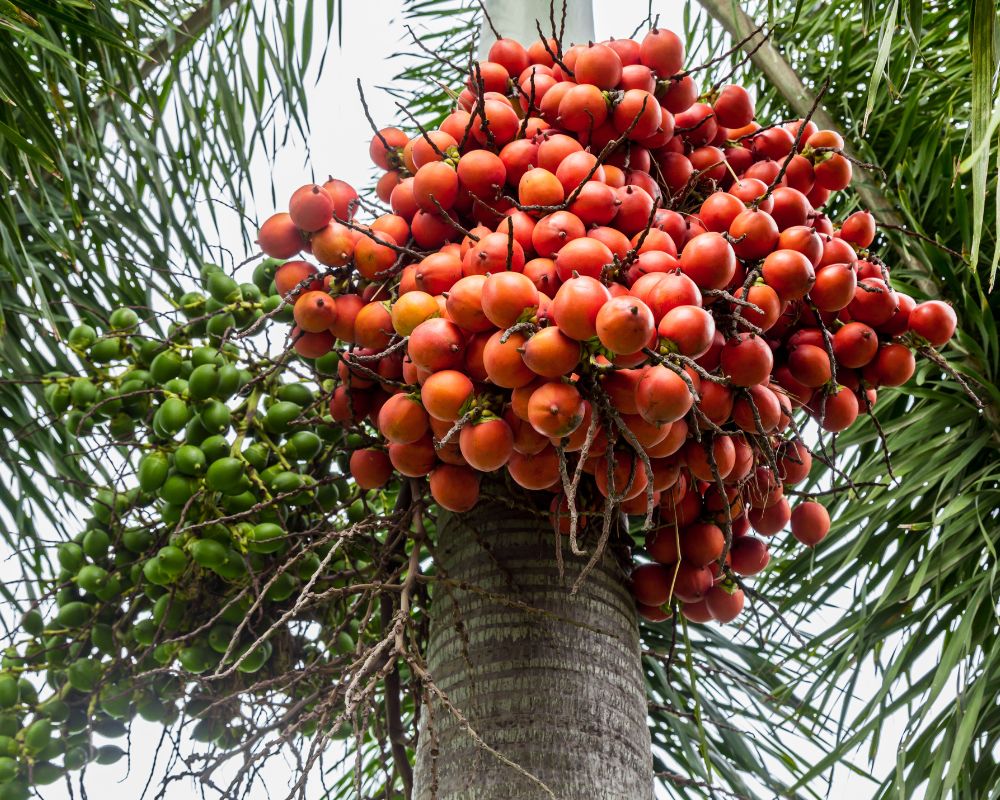
The economic part is used mainly for masticator purposes by the people. The raw kernel is chewed by Indian population in tender, ripe or processed form become more popular in the country.
The nutrient use efficiency of the Arecanut crop is very low and the post-monsoon period from December to May is highly critical for nutrient and water supply.The palm has a shallow root system with more than 70% roots occurring in the upper 60 cm of the soil and within a radius of 60 cm from the palm. Maintenance of soil quality and health in perennial crops like arecanut is a major challenge due to nature of root system.
Adverse effects on soil health and quality arise from nutrient imbalances, soil pollution and soil loss processes and susceptibility to drought, pests and diseases.
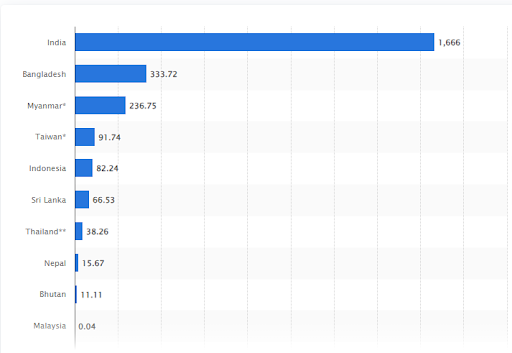
The economic production of arecanut is called “betel nut” and is used mainly for masticator purposes by the people of India. The raw kernel is chewed by Indian population in tender, ripe or processed form. It is processed and used into panmasala, gutkha, scented supari etc. are some treated which are become more popular in the country. The cultivation of arecanut production can be traced back to Vedic periods, where we can see the use of it.
Arecanut (Areca catechu L.), which belongs to family Palmae, is one of the most important plantation crops in humid tropics of India.
The palm grows to a height of about 10–15 m with an average production of 8–9 leaves per year. The average leaf area of the palm is estimated as 25 m2 and net photosynthesis ranges between 2.4 and 8.2 μmol CO2 m−2 s−1 . The maximum numbers of inflorescences are produced during December–March. Hence, the post-monsoon period from December to May is highly critical for nutrient and water supply. The palm has a shallow root system with more than 70% roots occurring in the upper 60 cm of the soil and within a radius of 60 cm from the palm.
Arecanut is predominantly cultivated in laterite soils, Laterite soil is formed in areas with heavy rainfall and high temperatures, where rainwater leaches away soluble minerals from the soil. This process is called laterization. The acids in the rainwater dissolve minerals from the parent rock, resulting in a pH value less than 7, which have inherent constraints like P fixation, rapid hydraulic conductivity, faster infiltration rate, leaching of basic cations and low CEC (3–15 cmol kg−1). Deficiency of N and K was reported in laterite soils of Karnataka. Further, the authors noticed that leaching of K+ and Ca2+ due to heavy rainfall is a major production constraint in arecanut tract. The annual nutrient mining by arecanut is estimated as 79 kg N, 28 kg P2O5 and 79 kg K2O per hectare. The nutrient use efficiency of the crop is reported as very low: 10–15% for nitrogen, 25–30% for phosphorus and 20–25% for potassium. Thus, this perennial palm requires large quantity of nutrients to support its growth and yield. Considering the soil and crop constraints, fertilizers should be applied in synchrony with crop demand in smaller quantities during post-monsoon season.
Under arecanut production, India is in first position with respect to area (43.01%) followed by Bangladesh (33.00%), Indonesia (11.27%) and Myanmar (5.71%). Similarly, with respect to the production also India ranked first (50.37%) followed by Bangladesh (18.27%) Myanmar (11.31%) and Indonesia (7.37%). Further, arecanut also cultivated in small scale in some countries like Nepal, China, Srilanka and Malaysia. The average productivity of arecanut at world level stood at14.60 q/ha. Among different arecanut growing countries, Srilanka stood first with a productivity of 35.14q/ha followed by Nepal was (33.10q/ha) and Myanmar (29.00q/ha). Although, India stands first in global production, its performance in productivity is poor with its global ranked 7th in terms of productivity with productivity level of 17.15q/ha which considered almost on par with world productivity level. (2021-22)
The states which predominately grown arecanut in India are Andhra Pradesh, Assam, Meghalaya, Tripura, Andaman and Nicobar Islands, Maharashtra, Goa, Karnataka, Kerala, Tamil Nadu, Mizoram, West Bengal and Pondicherry. Furthermore, Karnataka and Kerala states have the significant share which together accounts more than 80 percent of both in area and production of the arecanut in the country. With respect to the area under arecanut across different Karnataka ranks first with a 5,00,522 hectares with production of 10,81,840 tonnes states, followed Kerala with an area of 96,921 hectares with production of 92,755 tonnes, Assam with an area of 67,021 hectares with production of 50,040 tonnes, Meghalaya with an area of 17,951 hectares with production 24,467 tonnes and West Bengal with an area of 11,890 hectares with production of 23,857 tonnes of arecanut produce during the year 2019-20. The present study attempts to examine the trends in area, production and productivity of arecanut in India and Karnataka as whole.
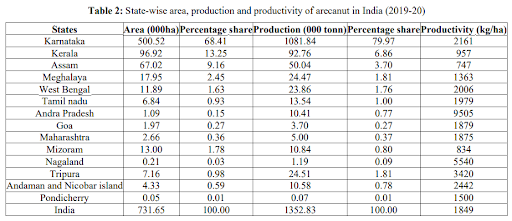
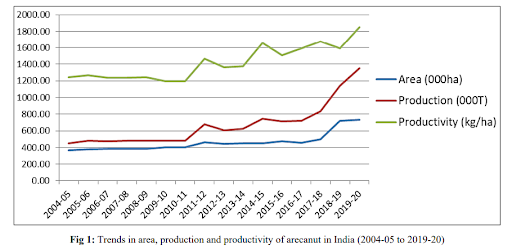
Maintenance of soil quality and health in perennial crops like arecanut is a major challenge due to intensive land use in small and marginal holdings. Arecanut (Areca catechu L.) is a commercial crop having social importance in India. Arecanut is predominantly cultivated in acidic laterite soils that account for 80% of soils under arecanut in traditional arecanut growing areas. During the last decade, there was rapid expansion of arecanut area in clay soil belt of non-traditional areas and in paddy fallows.
The productivity of arecanut is either stagnant or declining largely due to loss of soil health and soil quality. Stagnant productivity, reduced nut recovery, nutrient imbalances and disorders are becoming major constraints in arecanut production. Cultivation of exhaustive crops like arecanut continuously on the same land results in soil exhaustion. The soil fertility decline is widespread in tropics urges the management interventions at regular intervals for maintenance of soil health especially in perennial plantation crops. Adverse effects on soil health and quality arise from nutrient imbalances, excessive fertilization, soil pollution and soil loss processes. Thus, it is essential to replenish nutrients regularly
Constraints in Arecanut production
- Low nutrient retention and moisture holding capacities
- Soil laterization dissolve minerals resulting pH value less than 7
- Inherent P fixation
- Rapid hydraulic conductivity
- Faster infiltration rate
- Leaching of basic cations and low CEC
- Deficiency of N and K
- leaching of K+ and Ca2+
Why Arecanut need CAP Boooster?
The productivity of arecanut is either stagnant or declining largely due to loss of soil health and soil quality. Stagnant productivity, reduced nut recovery, nutrient imbalances and disorders are becoming major constraints in arecanut production.
Arecanut is heavy feeder of N and K compared to P, Ca and Mg and the total uptake of macronutrients is in the order of N > K > Ca > P > Mg. the appearance of disorders like crown choking, crown bending and oblique nodes is noticed in arecanut due to antagonistic nutrient interactions. Zinc deficiency is mainly responsible for development of disorders in arecanut. It is essential to replenish nutrients regularly.
Thus, this perennial palm requires large quantity of nutrients to support its growth and yield. Considering the soil and crop constraints, fertilizers should be applied in synchrony with crop demand in smaller quantities during post-monsoon season
1. CAP Boooster promotes stem thickness, strength, and healthiness of palms
2. Continuous recharging of palms with CAP Booosters assures sustained nutrient supply
3. Immediate recovery from the nutrient disorders/ maladies
4. Improves soil enzymes by the production of enhanced root exudates
5. Encourages the synergism soil microorganisms improves active root zone health and enabling the tree to absorb more nutrients.
6.Facilitates uniform fruit set and increase the fruit size and weight by the enhanced and timely pollination
7. Increase the tree vigour, provide resistant to pest and diseases
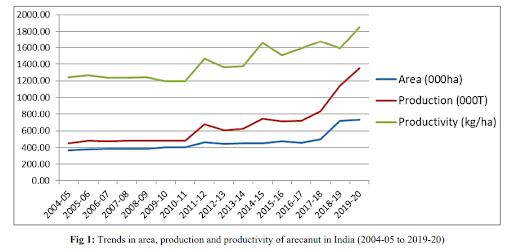
The soils in arecanut belt are poor in native soil fertility with abundant sesquioxides and low bases. Further, heavy rainfall aggravates the problem by leaching away of nutrients like N and K. In these soils, N and K are highly mobile and labile, while P is highly immobile and fixed. Even though the parent materials have their distinctive influence on the development of acidity in soils, rainfall and temperature in general appeared to be more dominant factors. Intense leaching of bases accompanying the high rainfall conditions, presents a distinct acid character to the soils. The CEC of the soils is quite low. Kaolinite is the dominant clay mineral and as such there are no K fixation sites.
Conclusion
Arecanut cultivation is one of the state’s main economic activities, providing a significant source of money and employment for the population. As it is considered to be commercial crop arecanut area, production and productivity have all increased significantly over the last fifteen years, indicating that it is a major crop with a strong compound growth rate. Arecanut grew at the fastest pace in terms of area, production, and productivity during the study period. Arecanut productivity was found to be stagnant in all of the examined districts except Davanagere districts (2.32%) and Karnataka state as a whole over the study period, which was attributed to a lack of technological advancements and increased insect and disease attacks to the arecanut. As a result of the majority of farmers using native varieties in their crops, productivity growth was poor. So, in order to enhance output, extending the area under high yielding cultivars in the research region is a priority.
Soil constraints and management strategies:
The cultivation of arecanut on slopy lands/paddy fallows/eroded lands in Western ghats and clay soil regions is a major constraint. Generally, these lands are not suitable for monocot palms as per Land Capability Classification. If the farmer’s preference is for cultivation on these problematic lands, adoption of management strategies like improvement of soil aeration, proper drainage and breaking hard pan in paddy fallows, and soil and water conservation measures like terracing and planting of vetiver on slopy lands is necessary. It can be grown in fertile clay loam soils with special care and microsite improvement to tackle problems like water stagnation, poor soil aeration and slow infiltration. In paddy fallows, seepage of water and continuous water stagnation above field capacity level in the root zone cause severe problems to plant growth and nutrient uptake (Bhat and Sujatha, 2014 and Bhat et al., 2016).
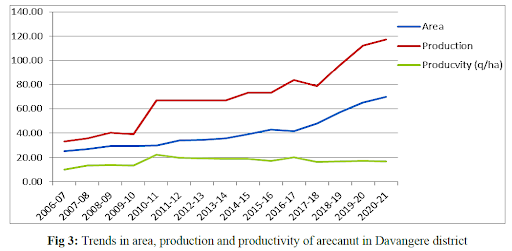
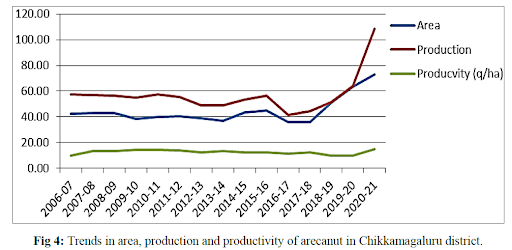
Low nutrient retention and moisture holding capacities are important constraints in laterite soils because of low cation exchange capacity, faster infiltration rate and high hydraulic conductivity and porous nature of soils. Leaching of basic cations like potassium, calcium and magnesium due to heavy rainfall reduces the crop in humid tropics. It is well known that K deficit results in low nitrogen use efficiency, and susceptibility to drought, pests and diseases.
The results indicated that arecanut is heavy feeder of N and K compared to P, Ca and Mg and the total uptake of macronutrients is in the order of N > K > Ca > P > Mg. Though availability of nutrients in the soil is above optimum, the appearance of disorders like crown choking, crown bending and oblique nodes is noticed in arecanut due to antagonistic nutrient interactions. Reduced Zn uptake by arecanut due to very high soil test P in clay soils causes widespread crown choking. Zinc deficiency is mainly responsible for development of disorders in arecanut. Crown choking can be identified at initial stages with appearance of dark green leaves with erect nature and reduced leaf size. Excess availability of nitrogen, phosphorus and other nutrients hinder uptake of zinc and cause disorders.
Combined deficiency of zinc and calcium causes crown bending. Nut splitting is due to less potassium and application of potassium is required to correct nut splitting as both husk and kernel require high potassium. Thus, soil health is important that can be maintained through balanced nutrition.
Leaf nutrient limits for arecanut Optimum leaf nutrient concentrations and ranges are established for arecanut (Bhat and Sujatha, 2013) and this could be used for precision 18 agriculture and for diagnosing the deficiencies or toxicities. The leaf concentrations for N (2.70%), P (0.23%), K (1.12%), Ca (0.61%) and Mg (0.2%) are optimum for bearing arecanut. Optimum micronutrient concentrations are 146 ppm for iron (Fe), 56.5 ppm for manganese (Mn), 2.6 ppm for copper (Cu), 45.8 ppm for zinc (Zn) and 39.5 for boron (B).
How to mix CAP Boooster
- Add 15 litre of good quality water with 1litre of concentrated CAP Boooster to make 16 litre of diluted CAP
- Take 100 ml in a polythene pouch and feed to one tree
- 160 trees can be fed with 16 litre of diluted
CAP BOOOSTER
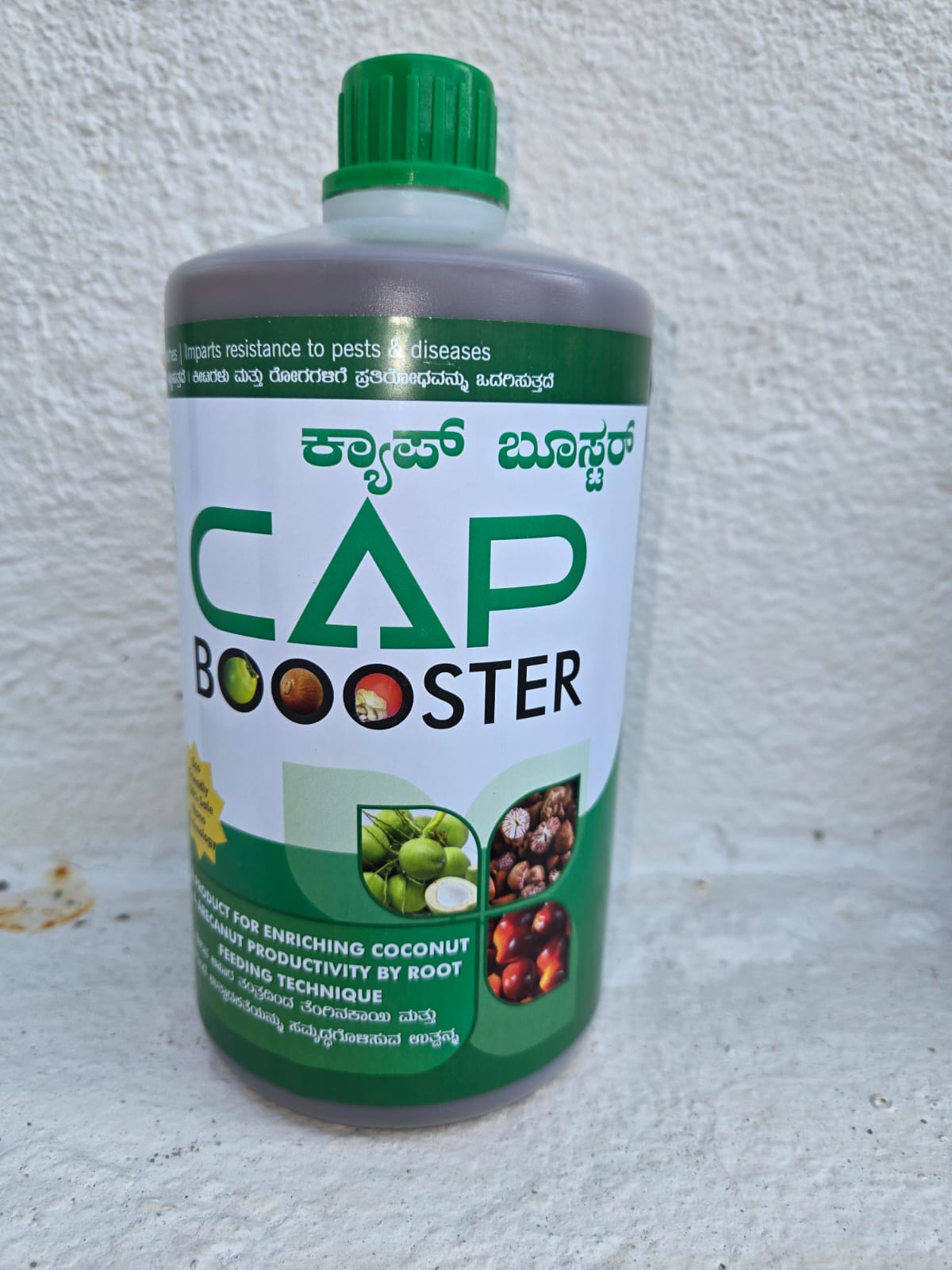
Benefits of CAP Boooster
- Increases green pigment content of leaves
- Increases the leaf number and size
- Improves photosynthetic capacity
- Decreases button shedding/ nut fall
- Increases kernel thickness
- Increases nuts number and weight of nuts
- Increases lifespan and vigour of the palm
- Imparts immunity to pests, diseases
- Imparts tolerance to moisture stress



